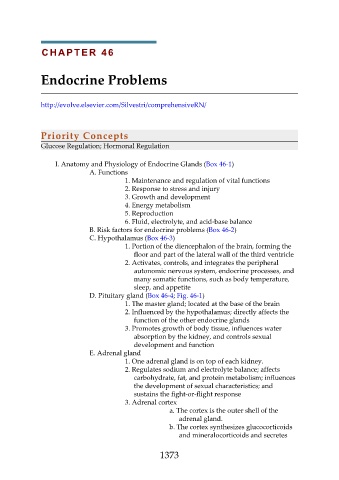Page 1373 - Saunders Comprehensive Review For NCLEX-RN
P. 1373
CHAPTER 46
Endocrine Problems
http://evolve.elsevier.com/Silvestri/comprehensiveRN/
Priority Concepts
Glucose Regulation; Hormonal Regulation
I. Anatomy and Physiology of Endocrine Glands (Box 46-1)
A. Functions
1. Maintenance and regulation of vital functions
2. Response to stress and injury
3. Growth and development
4. Energy metabolism
5. Reproduction
6. Fluid, electrolyte, and acid-base balance
B. Risk factors for endocrine problems (Box 46-2)
C. Hypothalamus (Box 46-3)
1. Portion of the diencephalon of the brain, forming the
floor and part of the lateral wall of the third ventricle
2. Activates, controls, and integrates the peripheral
autonomic nervous system, endocrine processes, and
many somatic functions, such as body temperature,
sleep, and appetite
D. Pituitary gland (Box 46-4; Fig. 46-1)
1. The master gland; located at the base of the brain
2. Influenced by the hypothalamus; directly affects the
function of the other endocrine glands
3. Promotes growth of body tissue, influences water
absorption by the kidney, and controls sexual
development and function
E. Adrenal gland
1. One adrenal gland is on top of each kidney.
2. Regulates sodium and electrolyte balance; affects
carbohydrate, fat, and protein metabolism; influences
the development of sexual characteristics; and
sustains the fight-or-flight response
3. Adrenal cortex
a. The cortex is the outer shell of the
adrenal gland.
b. The cortex synthesizes glucocorticoids
and mineralocorticoids and secretes
1373

